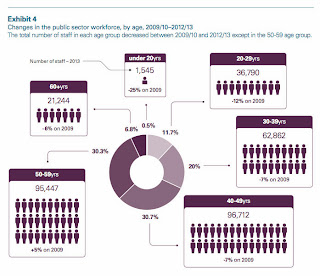Today’s Audit Scotland’s report on the public sector
workforce shows clearly how it’s the workforce that have taken the brunt of
spending cuts.
It shows that staff costs have been cut by over £1bn between
2009/10 and 2011/12. And that doesn’t include the savings from pay restraint.
26,600 whole time equivalent (WTE) posts were cut between
March 2009 and March 2013 (7%). Some 9,665 were transferred to arms length
bodies outside the public sector. 15,816 WTE left through early departure schemes,
although these have been reducing in recent years. Councils made the biggest reduction (10%)
while the NHS had the smallest cut (1%).
The report, if anything, understates the picture because the
numbers are converted into WTE. In terms of real people (headcount), 48,700
have gone (excluding the financial sector) since the height of public sector
employment just before the financial crash - 5,500 people in the last year
alone.
Given the scale of early departure schemes it might be
expected that the numbers of older staff would be reducing. However, the report
shows that the only age group that is increasing is 50-59yrs, up by 5%.
Probably due to recruitment freezes the numbers of younger workers are falling.
The chart below illustrates this change.
The report sets out the range of methods used by public
bodies to reduce workforce costs with pay restrictions, vacancy management and
early retirement the most common. More than a third of councils used compulsory
redundancy. There is some criticism of the level of evaluation of early
departure schemes.
Future workforce changes are inevitable given the budget
cuts to come. The report outlines a range of ways this might be achieved,
including considering service delivery cuts. The report recommends better
national and local workforce planning.
Overall, the report is a useful description of what has
happened to the public service workforce in Scotland. The recommendations are
largely sensible, but little more than a sticking plaster over the impact of spending
cuts to come.


No comments:
Post a Comment